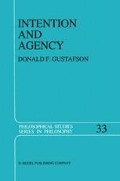Abstract
Intentions appear, typically, in the conscious thinking of agents as the result of considerations, choices, decisions, desires, interests, felt obligations, roles in institutions and groups, emotions, moods, motives, and other traits of character, and other intentions. Intendings are the dispositions, states or episodes whose contents are intentions. An intending is a thinking what to do oneself and, typically, how to do it. The contents of intendings are expressed in full sentences in the typical case. They are also expressed in ‘free standing’ infinitives, gerundial forms, or appropriate verbs. The form of expression is not crucial to the content expressed, since there are intentions which cannot be expressed linguistically (by children, for instance, and by the inarticulate). Further, some intentions are never formulated by agents who are under the pressure of necessity for action. Necessities of time and contingencies and opportunities do not wait upon linguistic formulations of what one is about to do, is doing, or has done, intentionally. Sometimes, of course, intentions are expressed in explicit ways, e.g., “I shall...”, “I will...”, or in free-standing sentences. In these cases, intention contents are expressed in verbs of action, gerunds, infinitives, and that-clauses. Only preferences of style select among these forms. Thus, propositional that-clauses are not essential; nor are expressions in infinitives essential.
A man... is acted on at once by an impulse to avenge an affront, by a bodily want, by a call to duty, by a fear... He presents them to himself as influences by which he is consciously affected but which are not he, and with none of which he yet identifies himself... none is yet his object... when the man’s relation to these influences is altered by his identifying himself with one... This is to will... But in the act of will the man does not cease to desire... The object is one which for the time the man identifies with himself, so that in being determined by it he is consciously determined by himself... it is not from them, but from himself as affected by them, that the action proceeds.
T.H. Green
Access this chapter
Tax calculation will be finalised at checkout
Purchases are for personal use only
Preview
Unable to display preview. Download preview PDF.
Author information
Authors and Affiliations
Rights and permissions
Copyright information
© 1986 D. Reidel Publishing Company, Dordrecht, Holland
About this chapter
Cite this chapter
Gustafson, D.F. (1986). Dynamics of Intentional Action. In: Intention and Agency. Philosophical Studies Series in Philosophy, vol 33. Springer, Dordrecht. https://doi.org/10.1007/978-94-009-4520-3_8
Download citation
DOI: https://doi.org/10.1007/978-94-009-4520-3_8
Publisher Name: Springer, Dordrecht
Print ISBN: 978-94-010-8514-4
Online ISBN: 978-94-009-4520-3
eBook Packages: Springer Book Archive

